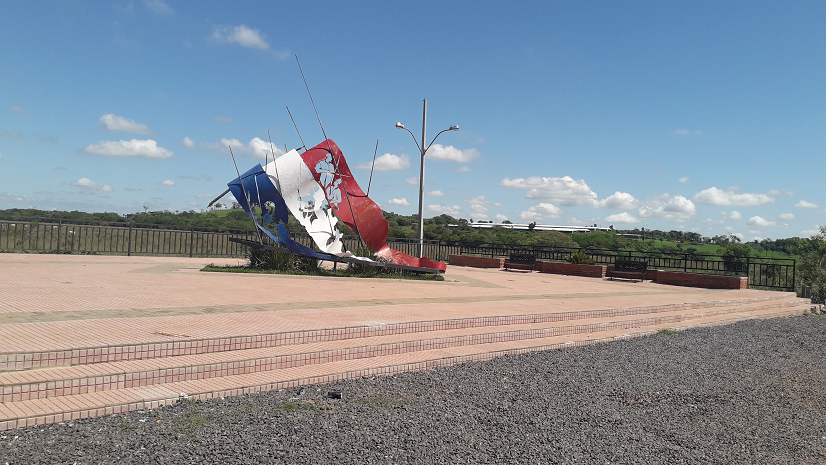The battle of Acosta Nu was the last mayor battle of the Triple Alliance War. The remnants of the Paraguayan army was heavily out numbered by the Alliance troops. These were mostly Brazilian along with some Argentines.
Following the loss of Asuncion in late 1868 the Paraguayans under the leadership of Mariscal Lopez had been making a fighting retreat across Paraguay. With every confrontation with the Alliance forces their numbers were diminished and they were pushed every further westwards.
For several months Piribebuy had been their base and had acted as the capital of Paraguay. In rival to the government set up in Asuncion by the Alliance.
On the morning of the 12th August those forces reached Piribebuy. The Paraguayans were again defeated and lost many of their remaining adult males in the combat.
Mariscal Lopez did escape the carnage with his shrinking forces and the Paraguayan court was on the road once more.
They headed first to Caacupe. The only sizable town in the area. However when the pursuing Alliance forces arrived there on the 15th they found that the Paraguayans had already moved on. Mariscal Lopez had once again got away
By now the Brazilians had become frustrated with the refusal of the Paraguayans to surrender and accept defeat. As far as they were concerned the war was already over and they were wasting time and men in pursuit of an enemy that refused to grasp that reality.
They understood though that the devotion the Paraguayans felt towards Mariscal Lopez meant that they were prepared to fight to the bitter end. After every engagement those that had not been slain simply got up and continued to fight on.
The Brazilians were going to give no quater.
So it was then that the advance guard of 20,000 men send out to destroy the Paraguayans made contact with the Paraguayan rear guard early in the morning of the 16th August. They were in a wide open plain crossed by a couple of small rivers. The place was maned Acosta Nu.
The terrain was ideal for the cavalry which made up the bulk of the Alliance forces on the day. However it was the infantry who first engaged the Paraguayans at around 8.30 in the morning.
Against those 20,000 battle hardened troops the Paraguayan commander had between just 4 and 6,000. As this was the rear guard and the as majority of the Paraguayan men were already dead or captured his forces were mainly children along with a few women and elderly.
It must have been obvious how one sided the fight would be. Despite that the Paraguayan general Bernadino Caballero chose to stand and fight what could only be a suicidal battle rather than trying to run.
The Paraguayans were poorly armed and being civilians on the while poorly trained but were ready to fight with the determination shown by their leader.
They did have eight cannons as artillery. They managed to pull these back over one of the small rivers but they were soon lost.
From then on all the Paraguayans could do was form squares and make suicidal charges out at the oncoming cavalry.
The squares were worn down by repeated cavalry charges and no mercy was shown to anyone venturing outside them,
Children charged the approaching horses often armed with little more than sticks and stones and were cut down in their hundreds.
Such though was the determination of the Paraguayans that they managed to hold out against everything that was thrown at them for eight hours.
As the battle drew to a close there was one last act of destruction to be handed out by the Brazilians.
Some of their cavalry had manged to get behind the Paraguayan lines and spotted people moving away from the battle field. In view of what had happened after previous battles they took them to be soldiers withdrawing to fight another day. They were in fact women and a small part of the baggage train who had taken no part in the battle.
To ensure that no one else followed this imagined escaping army the battlefield was set alight killing those who lay wounded on the ground.
In the battle the Paraguayan causalities were 2,000 dead and 1,200 captured. The figures of 46 dead and 259 wounded amongst the Alliance forces reinforce how one sided the confrontation was.
The battle and the great number of children who died in it remains deeply part of the Paraguayan conscious.
Thereafter the 16th August was made Children’s Day in Paraguay. Although these days children celebrate with clowns and parities it is the sacrifice of young people like them that is being remembered.
The battlefield was somewhere I had heard much about but never actually had the opportunity to visit. So yesterday i took for myself.
It was only about an hours ride to get there and once I had turned off the main road a good ride along a smooth rode through countryside that just became emptier and emptier.
When I reached the memorial site I was not surprised to find I had the place to myself. A familiar situation at historic locations in Paraguay.
The battlefield memorial itself was simple. A Paraguayan flag with the shapes of soldiers cut though it.
In addition to that there was a notice board and a raised platform with a few benches.
From the platform which looked west, the way the Alliance troops would have come it was clear just how well suited the ground would have been for cavalry and how there would have been nowhere to hide from them.
It is still a very rural area and looks now not much different to how it would have done in 1869.
The only real difference was that armed men have been replaced by a heard of cattle that now grazes peacefully across the broad open plain.


Recent Comments